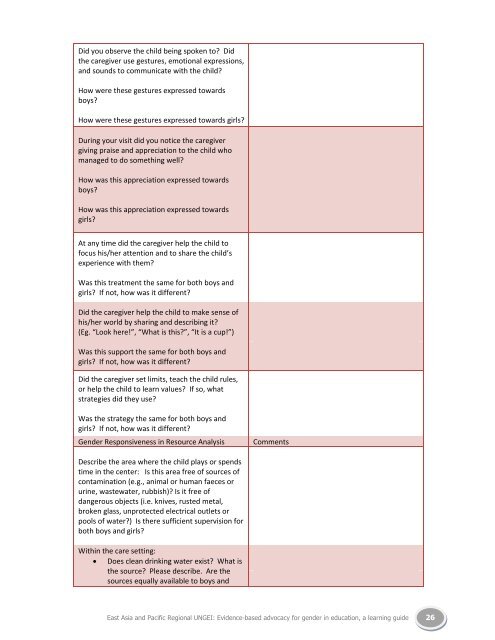Evidence-Based Advocacy - United Nations Girls' Education Initiative
Evidence-Based Advocacy - United Nations Girls' Education Initiative
Evidence-Based Advocacy - United Nations Girls' Education Initiative
You also want an ePaper? Increase the reach of your titles
YUMPU automatically turns print PDFs into web optimized ePapers that Google loves.
Did you observe the child being spoken to? Did<br />
the caregiver use gestures, emotional expressions,<br />
and sounds to communicate with the child?<br />
How were these gestures expressed towards<br />
boys?<br />
How were these gestures expressed towards girls?<br />
During your visit did you notice the caregiver<br />
giving praise and appreciation to the child who<br />
managed to do something well?<br />
How was this appreciation expressed towards<br />
boys?<br />
How was this appreciation expressed towards<br />
girls?<br />
At any time did the caregiver help the child to<br />
focus his/her attention and to share the child’s<br />
experience with them?<br />
Was this treatment the same for both boys and<br />
girls? If not, how was it different?<br />
Did the caregiver help the child to make sense of<br />
his/her world by sharing and describing it?<br />
(Eg. “Look here!”, “What is this?”, “It is a cup!”)<br />
Was this support the same for both boys and<br />
girls? If not, how was it different?<br />
Did the caregiver set limits, teach the child rules,<br />
or help the child to learn values? If so, what<br />
strategies did they use?<br />
Was the strategy the same for both boys and<br />
girls? If not, how was it different?<br />
Gender Responsiveness in Resource Analysis<br />
Comments<br />
Describe the area where the child plays or spends<br />
time in the center: Is this area free of sources of<br />
contamination (e.g., animal or human faeces or<br />
urine, wastewater, rubbish)? Is it free of<br />
dangerous objects (i.e. knives, rusted metal,<br />
broken glass, unprotected electrical outlets or<br />
pools of water?) Is there sufficient supervision for<br />
both boys and girls?<br />
Within the care setting:<br />
Does clean drinking water exist? What is<br />
the source? Please describe. Are the<br />
sources equally available to boys and<br />
East Asia and Pacific Regional UNGEI: <strong>Evidence</strong>-based advocacy for gender in education, a learning guide 26

















